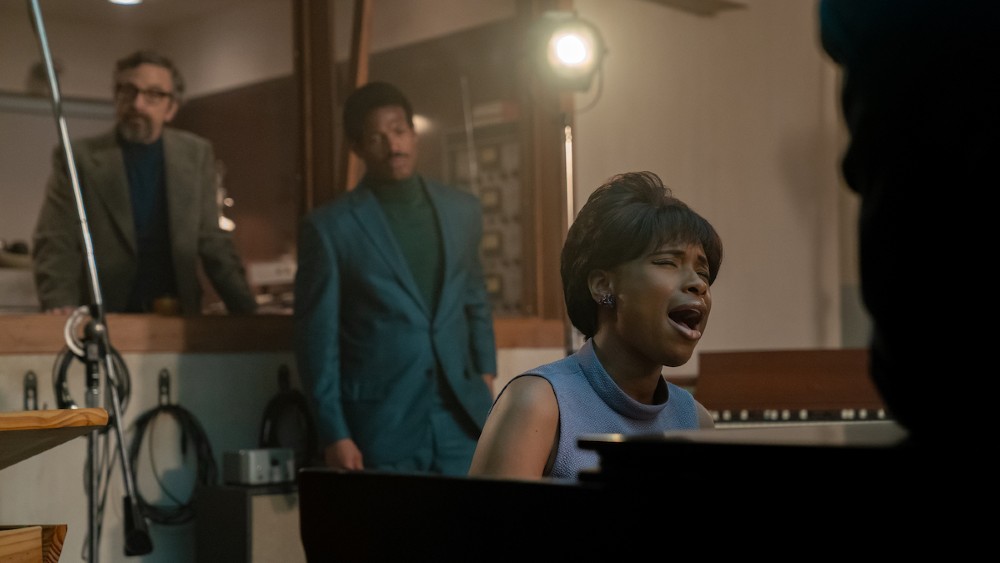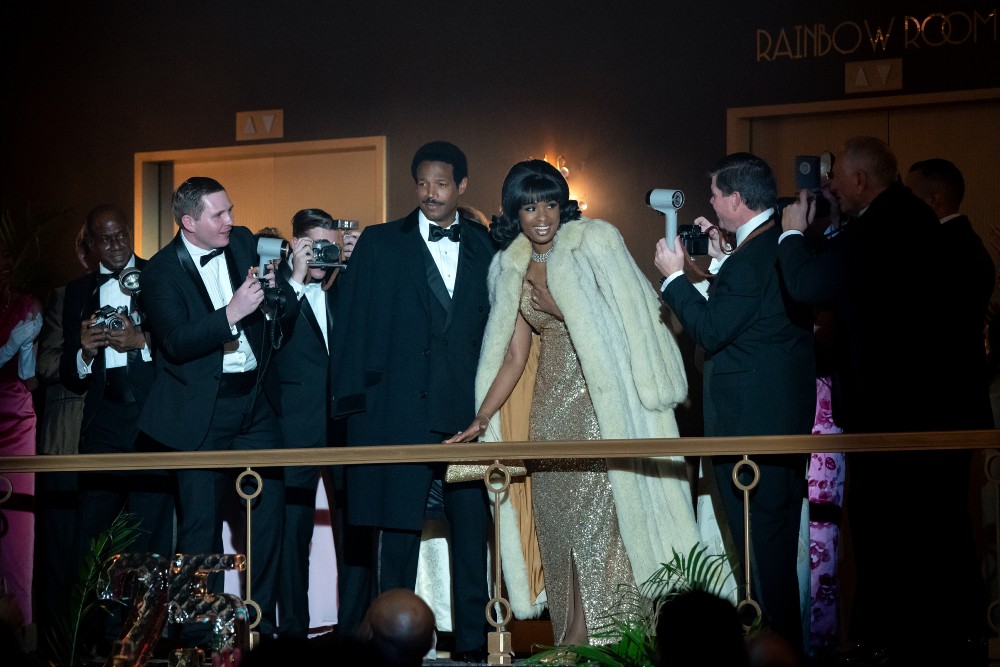
Respect Production Designer Ina Mayhew always knew that she was going to end up in media, but her path directed her towards film when a movie was being produced on campus while she attended college.
Prior to working on Respect, Mayhew and filmmaker Lisel Tommy worked on Queen Sugar and Dolly Parton’s Heartstrings. Because of this, the two had already developed a shorthand by the time they started working on the Aretha Franklin biopic.
Mayhew described her design process at length, discusses the most challenging set in the film, and talks about the challenges that come with working on a period film compared to a contemporary film. She also talks about authenticity and how much of it is important in a biopic. Mayhew is no stranger to contemporary films having worked with filmmaker Tyler Perry on a number of films together.

Below the Line: How did you first become interested in production design?
Ina Mayhew: I was always a film buff as a kid and I credit that to my mother in particular, who also took me around to the theater. I started as a theater designer in school. There was always an interest—I just never knew how to do it. They were filming a movie where I went to college—SUNY Purchase—and for some reason, as soon as I saw that, that was it for me. I was like, that is what I want to do. I really love the idea of four walls. I always wanted to complete the world. Theater is three walls, but I love that idea. It was immediate. And so from that moment on, I tried to figure out—through the schooling that I was going to—how do I do that. I kind of started to become friends with the people in the film department and really tried to find a way through those kinds of relationships and how can I take my skills as a set designer into film design. It was kind of that was for me. I did my best to keep trying to hang in there, trying to discover a path to film, I think, at the time.
It was a little bit more difficult, because I did not go to school for film. I went to school for theater, and I also was an artist and painter as well. Those were my skills. But that’s how I started was really just watching something filmed. It was, again, to coin a phrase from Oprah, it was that ah-ha moment. That was it—I never changed my mind and that was very early in life.
BTL: Do you often think about what your life would be like if they had not been filming on campus?
Mayhew: I was still kind of attracted to film. I also studied costume design. What was interesting is that my take on the costumes was if I was designing it for a film. There were parts of it that were already in me, that were already kind of going in that direction anyway, and that I was making friends all these film people. I think I would have ended up in the media anyway. It probably would have taken a lot longer. But no matter what, I loved the idea of anything having to do with that set design, anything having to do with environment. That was what I wanted to do starting in high school. The one thing that was really interesting—in my English class in high school, we made a short film. It probably was always there in the back of my head and was like an assignment. We had to go film something, edit it, put music to it, and everything. Oddly, it was in my English class. There was always a part of me that loved it. I just think this was that spark that really said, Oh, I see. I can do design for film. That’s something I didn’t really know about. I don’t know. I have to say that I still would have creeped into it somehow. I also started doing projections early on in some theater pieces that I designed, so I could feel that it was always a part of me and that I was always interested in it. I love the idea of photography, images, and things a little bit that were not traditionally theater. I was gonna get into film design one way or another—that’s for sure.
BTL: When it came to working on Respect, did they reach out to you or did you reach out to them?
Mayhew: Liesl reached out to me.
BTL: How big of an Aretha Franklin fan were you coming into the film?
Mayhew: I was a huge Aretha Franklin. It’s funny, because when I was doing a little bit of research, I was looking through my vinyls and I realized I actually had quite a few of her records. Of course, I listen to her all the time, so it was very comfortable to get into her life.
BTL: Did you have a favorite song or album?
Mayhew: It’s always funny, because when someone’s asking me, I don’t know. I guess—not to be cliché—about saying “Respect” but it has been such an anthem and something I know very well. I know the word to so many like “I Never Loved A Man” and of course, “Respect.” I just sing along with them. I don’t really have a favorite, but I definitely love the older songs rather than some of the newer ones. “Who’s Zooming Who?” I love some of the newer ones, too, but my favorite part of my life growing up are certainly her earlier songs, if that answers your question.
BTL: Having worked with Liesl Tommy on a few other projects before Respect, was it at a point where you had a shorthand between each other when it comes to collaborating?
Mayhew: Yes, I think that was one of the great things. We did a couple of episodes on two different shows, Queen Sugar and Dolly Parton’s Heartstrings. I think, especially on Queen Sugar, we had a lot of time to talk. We spent a lot of time together, kind of understanding where she comes from. Also, because both of our roots are in theater, that was kind of a nice shorthand as well. We kind of prefer certain elements of scenery that we like or techniques, and we could always kind of go back to that. It was nice being able to kind of spend a luxurious amount of time on that show, so by the time we got to Respect, we kind of eased into concepts and started talking about our first thoughts easily. What was nice also is the ease of going back and forth without any action. I think it not only was a shorthand, but it was kind of comfort to know each other already and we didn’t have to learn that about ourselves. We already knew each other pretty well. It was a pleasure to work with someone that I knew. It was really enjoyable.
BTL: This film spans the early ‘50s to the early ‘70s. Did you have a particular production design process for the film?
Mayhew: We all know that era very well, so I kind of just started searching for either iconic imagery of the time. My beginning process was looking at photos, paintings, artists, of course, her life, just kind of getting a feel for the era as well as the 60s and to see how what that transition was like. That was kind of a big deal between how drastically things change from the 50s to the 60s. I wanted to understand that process. As soon as I did, I started to think about interiors — my next thing was looking at color palettes and how that shifted. Those are kind of my very beginning is really researching the era and styles and then kind of really trying to really dive into especially her life—understanding what class she was in, middle class, upper class, working class. Discovering that—that took actually kind of a little bit more time to really find African-American families that were middle class or upper middle class. It’s kind of this slow journey that I begin with things that I love, photos that I love. That kind of hits me right away as I’m thinking about the movie, mood, and starting to think about a little bit of style, initial concepts without necessarily talking to Liesl and then after that, things start to shift and mold.
I kind of grow from these beginnings and do a lot of research, which I love, no matter if it’s contemporary or a period. I just kind of dig in and see how these people live, and what can I do in terms of enhancing the images, the imagery, the places where they live? What’s the essence of their lives and physical objects? That’s kind of my process. As soon as I really digest the era, I feel like I fairly quickly go into actual design, meaning that, Okay, we’ve made a decision about the style. Which way we’re going to go using some historic elements. Aretha Franklin’s life in particular is very hard to find, but we had to find similar things to that era. I want it to feel like a hombre of images turning one way and growing into something else. I do a lot of pictorial research—lots of printed things, lots of things that I stare at. I watch a lot of films if I can. How do I take the things that I love and also incorporate it in that it makes sense. That is kind of also an emotional part to how I think of the film and how do I show that in terms of tones—warm, cool, pretty, blues, pinks—things like that. Those kinds of things hit me and I start from there. It’s a long answer but anyway, it’s a very big process for me.
BTL: Was there a set in the film that you found the most challenging to design?
Mayhew: The house, actually, was very challenging. I found just trying to get the structure right and making sure that I was accurate in spirit to her house—even though I did go and actually look at the house—was definitely challenging. I also really wanted to make sure I got the recording studios right. Any of those things where there’s not a lot of images to look at is always a bit of a challenge. There was a surprising set that I had to do: the Rainbow Room of the ‘60s, which was a decision that we made a little later in trying to recreate that. The challenging part are the things that you always have to recreate. One of the actors of the film is the home and so the interior, the exterior was a very important element to me. I found it challenging for sure to get that right and to feel authentic.
BTL: When it comes to working on biopics, how important is it to be authentic?
Mayhew: I’m gonna say that it’s 85% important because you want to at least feel that you’ve got the heart of the piece correct. Especially when it comes to the interior furnishings, it’s really hard to get completely accurate. So then, again, I start to really investigate how Aretha lived her life, how her family lived, and then I again go into the spirit of it and feeling that I know the characters and her family well enough that I feel good about making these decisions that, “This is what they would have had.”
And again, the same with all the offices, Columbia Records office, Wexler’s office, all of those we really studied as much of the footage as possible and trying to get the overall feel right—that was really important so that it feels authentic and not exactly duplicating. That’s a very difficult task unless you were able to match or build everything exactly. And again, it is also a bit of an interpretation all along with the acting, the music, even the wardrobe. Even Clint—when he reproduced some of the clothing, the rest had to be kind of interpreted in her style. We did the same thing. We were able to match a few things. And the rest, we just had to be as accurate as possible to the period. That’s really what we wanted to do—to get the sense of the period absolutely right so when you’re watching it, you feel like you’re there either in the house, in the recording studio or on the street in New York City. Getting that period, right is, I think, the most important thing.
BTL: What are the challenges that typically come with designing a period film as opposed to a contemporary film?
Mayhew: Again, we think that there’s a lot of information out there. A lot of research. There’s a thing about designers, we want to get it absolutely right. Really getting the research—I really, really do that a lot. That’s the hardest part is to find enough references and also look for actual things that were made at the time. I tend to make things now a lot. When you’re doing period stuff, you really have to reproduce a lot more. There’s a lot of things that entails—when you have the right craftsman to do that, time, budget. There’s a lot to consider, but I really do.
Where in a contemporary film, we can create differently where a period piece would really have to rely on history a lot more. Unless it’s something that is kind of invented and just, again, spirit of an era, I think all of us as designers really want to get it right. We are always looking for the right wallpaper, the right couches, everything of the era that was authentic at the time. Where contemporary, I can invent a bit more, I can kind of create the world a little differently. In a recent project that I did, I kind of had to do some period of work on that as well kind of back at the turn of the century and, again, was taking the pieces that feel right, using design elements that are correct, that throw you into that. I think that for me, I really, really want those authentic elements and that takes a different amount of time to do that. It actually takes longer to really get it right and research and thoroughly enough.
Respect is now playing in theaters nationwide.
All pictures courtesy MGM Pictures, except where noted.







